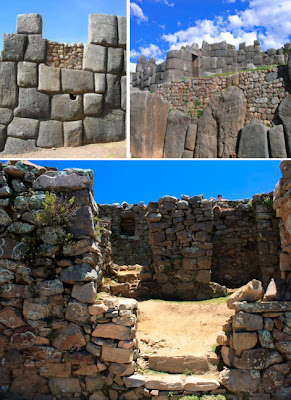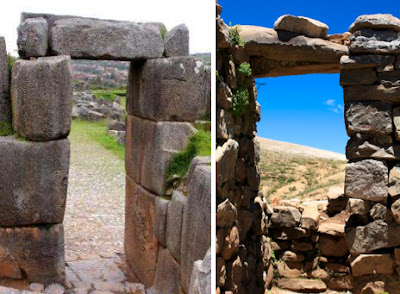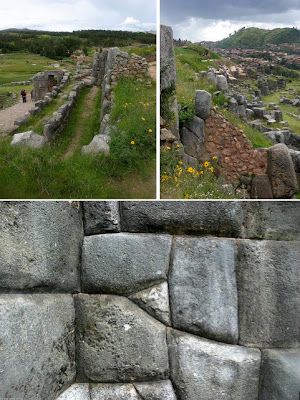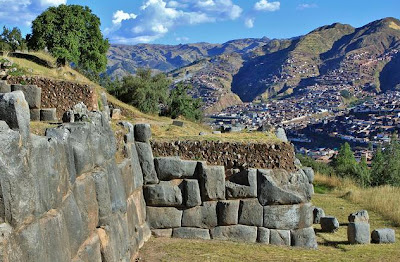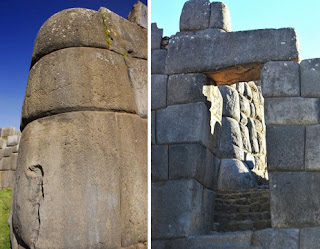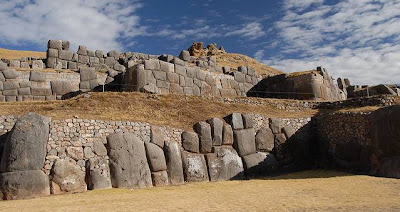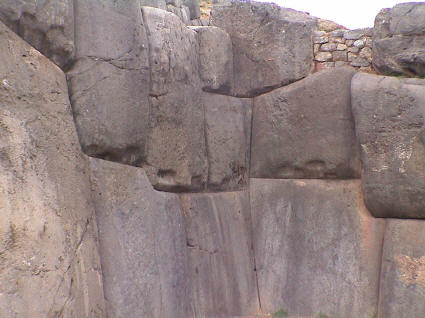Sacsayhuaman

Sacsayhuamán (also known as Saksaq Waman) is a walled complex near the old city of Cusco. Some believe the walls were a form of fortification, while others believe it was only used to form the head of the Puma that Sacsayhuamán along with Cuzco form when seen from above.
The megalithic structure at Sacsayhuaman in Peru has equaled those tolerances with huge multi-sided blocks which are all completely irregular in a kind of three dimensional jigsaw puzzle.

The best-known zone of Saksaywaman includes its great plaza and its adjacent three massive terrace walls. The stones used in the construction of these terraces are among the largest used in any building in prehispanic America and display a precision of fitting that is unmatched in the Americas.
Sacsayhuaman is said by many Archaeologist to surpass the Incas, by as much as 7 millennium. Some estimate the ruins to be as 10.000 BC. The Incas, took strategic advantage of the site, something seen with Rome constructing over the Balbeek temple around 9th BCE.
In addition, the Inca claimed to have finished just twenty years before the Spaniards arrived, and only about thirty-five years before the empire fell, yet the Spaniards did not described the fortress as being new or even near new, but looked like it had existed for a very long time, and frequently asked the Inca they conquered who built it—which the Inca often claimed for their own. However, the engineering accomplishments of Sacsayhuaman tell a different story.
Take for an example the fantastic construction of huge stones weighing hundreds of tons so perfectly cut and fitted, modern man cannot understand how it was accomplished with the types of tools known to the ancients. When the Inca later occupied this site, they tried to repair a few of the damaged walls, where a some anciently set big stones have fallen over the years, probably from earthquakes in the past. Their efforts show a lack of ability to come close to the original, magnificent work that is often attributed to them.
In addition, when the Spanish arrived, they used Inca labor to build on top of some of the ancient walls and structures. However, after two earthquakes, all the Inca had built came tumbling down while all the older pre-Inca walls and structures remained standing beneath the new, destroyed Inca work. Just look at the numerous examples below of excellent pre-Inca work, so precise and exact in fit and interlocking structure that modern engineers are amazed, and compare it to the few Inca repairs that are obvious of far lesser quality and knowledge. The difference is astounding:
Top Left: note the small rocks the Inca used to try and repair where a much larger stone had fallen; Right: Another place where the Inca used small rocks along the top course of the wall where some boulders tumbled down anciently; Bottom: An example of Inca stonework known to have been built during Inca times. Note the different between the repairs and this latter haphazard stacking of rocks with the giant, carved and perfectly fitted stonework of an earlier time
 Note the different abilities shown in these two examples of ancient stonework. Left: More recent Inca work; Right: Older stonework of Sacsayhuaman
Note the different abilities shown in these two examples of ancient stonework. Left: More recent Inca work; Right: Older stonework of Sacsayhuaman
Note the difference between these two lintel doorways. Left: An older doorway using large, carved blocks; Right: A more recent Inca doorway using small, non-carved, loosely fitting lintel and rocks
Left: Note the Inca repairs on the wall seen above the llama’s head; Right: More obvious Inca repairs showing their lack of ability to cut and fit stonework—they used small stones with which they could work, even tough the missing larger stones were available for use
Top Left: Top level of the three walls at Sacsayhuaman. Note the clump of stones in the center right where the Inca tried to repair the top wall; Top Right: More obvious Inca repair work; Bottom: Pre-Inca work—note the detail of fitting a small triangular rock in the center, which was beyond Inca capability
The lower wall. Note 1) the top stones that were torn down by the early Spanish to build their own churches and houses—they stopped lower down because they simply could not dislodge them; 2) the fortress overlooked the valley below (Cuzco)
Left: Note the perfectly rounded carving of all three stones of varying sizes, and especially the vertical cut and matching line to the right of the bottom stone so the middle stone overlapped for a stronger joint. In none of the repairs made by the Inca before the Spanish arrived was any such engineering capability shown; Right: Note the planning, even if an enemy could breach the lower wall, to get to the next level they had to pass through this single opening, that had an upward approach and steps, slowing progress, and having to pass the defenders on two levels above them
When it is said the Inca worked on Sacsayhuaman before the Spanish arrived, it should be noted that their work is very obvious, using small rocks, most unfitted, to fill in the missing huge stones that were once in place. Inca work was far inferior to that of the original builders
Even in small walls, care was taken to carve rounded corners, interlock stones, and even angle small stones to smooth off the top and make sure everything fit. Inca small stonework was simply a haphazard stacking of stones as shown in the above images
(See the next post, “The Inca: Occupiers or Creators – Part V,” for a real look at the Inca as they were, not as historians want us to believe they were)
The stones are so closely spaced that a single piece of paper will not fit between many of the stones. This precision, combined with the rounded corners of the blocks, the variety of their interlocking shapes, and the way the walls lean inward, is thought to have helped the ruins survive devastating earthquakes in Cuzco. The longest of three walls is about 400 meters. They are about 6 meters tall. The estimated volume of stone is over 6,000 cubic meters. Estimates for the weight of the largest Andesite block vary from 128 tonnes to almost 200 tonnes.
According to Graham Hancock, archaeologist, one of those stones is 29 feet high and weighs more than 360 tons; the equivalent of 500 passenger automobiles. That stone is not even at the base of the wall. Yet, the quarry from which the granite blocks were cut was more than 10 miles away.
Sacsayhuaman in Quechua the language means “Satisfied Falcon”
Although it is commonly referred to as a ‘fortress‘, the early chroniclers were unanimous in their opinion that it had a reputation as a Royal House of the Sun:
* Garcilaso de la Vega, who sates in his “Comentarios Reales” (“Royal Comments”) that people from Cusco knew, from ancient times, that this architectonic complex was actually a Royal House of the Sun. In chapter VI of his Seventh Book he says: “…an Inca with royal blood left the fortress as a messenger of the Sun…he left the fortress and not the Temple of the Sun, because it was said that he was a messenger of war not of peace, that the fortress was the House of the Sun”.
* Pedro Cieza de León, Spanish chronicler of the conquest times, states in his book “El Señorío de los Incas” (“The Incan Dominion”) that the Royal House of the Sun was located to the north of the city of Cusco, within a collado.”
* Martín de Murúa, also a Spanish chronicler, states that Sacsayhuamán “…was, at first, the House of the Sun, and nowadays it is only a witness of its ruin”.
Some of the stones show indentations which may have served a purpose in the construction process.
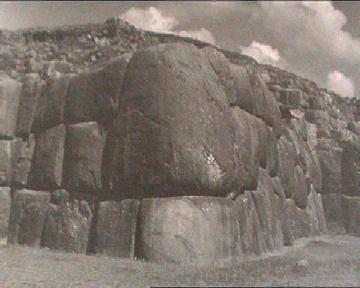
Although a substantial part of the walls has been removed over the ages (as much as 3m along their lengths according to archaeologists), what remains does so because it was too large to move.
Like all Inca stonework there is still mystery surrounding how they were constructed. Thanks to an as yet unexplained precision in stone-cutting, the structure is built in such a way that a single piece of paper will not fit between two stones. It is believed that Sacsayhuaman shared the same stone works seen in places like Puma Punku, and Giza. They have detected “thermo-heat” as if he rocks were dissolved by an acid or even cut with diamond drilling.
This precision, combined with the rounded corners of the limestone blocks, the variety of their interlocking shapes, and the way the walls lean inward (ubiquitous in Inca architecture), is thought to increase the ruins’ incredible durability–devastating earthquakes in Cuzco have left it undamaged.
The site remains a mystery which is making Archaeologist to reconsider the age of the site, and set it to a much older age, showing that the America pre-Inca and Mayan civilizations could be up to 5.000 BCE, older than the Mesopotamian civilization.
Archaeologist have also suggested that the ruins show human kind has developed high levels of civilization way before the evolutionary agenda, which disestablishes the notion of nomad tribes wondering the earth surpass the age of known civilizations.



